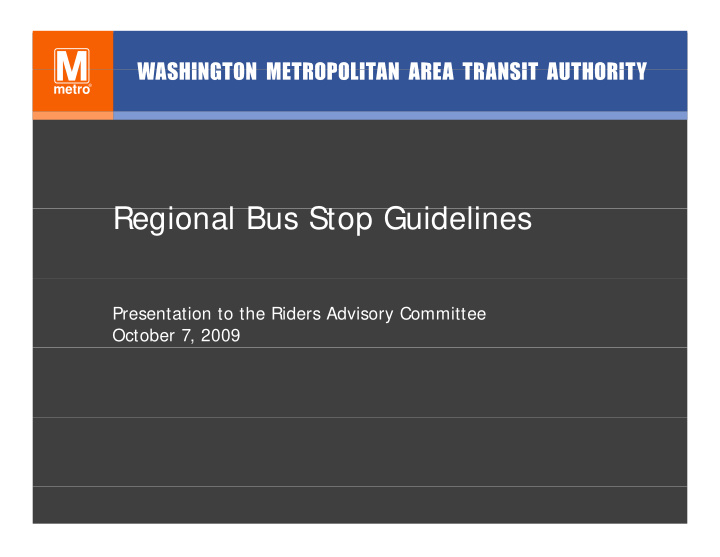



R Regional Bus Stop Guidelines i l B St G id li Presentation to the Riders Advisory Committee October 7, 2009
Purpose and Background Purpose and Background To provide the Riders’ Advisory Council with Information on the Development of Guidelines for the design and placement the Development of Guidelines for the design and placement of transit stops for WMATA • Study Conducted in Winter/Spring 2009 • Public Meeting was held to solicit comments on proposed design g p p g elements • Final draft report currently under review by internal and external stake holders 1
Study Goals Study Goals • Purpose – Consistent set of guidelines for Metrobus in the region – Uniform approach in designing and locating stops pp g g g p – Ensure greater access to services by all types of riders • A Application li ti – Guide for new and relocated stops – Guide for planned bus stop improvements – Incorporate into planning process for roadway, streetscape, and pedestrian improvement projects 2
Bus Stop Design E Bus Stop Design E lements lements • Bus Stop Sign • Bus Stop Post • Bus Stop Post • Information Case • Lighting • Lighting • Landing Pad/Passenger Waiting Area • Seating • Seating • Shelter • Trash Receptacle • Trash Receptacle • Vendor Boxes • Accessible Pathways • Accessible Pathways 3
Design Prototypes Design Prototypes Bus Stop Prototypes ensure that Metro Bus Stops are safe and Bus Stop Prototypes ensure that Metro Bus Stops are safe and accessible for all riders while aesthetic design elements are left to the discretion of each jurisdiction 4
Study F Study F indings indings Bus Stop Amenity Hierarchy was developed to address the wide variety of land uses and demand levels in the Metro Bus System levels in the Metro Bus System 5
Spacing Analysis Spacing Analysis • Reviewed studies Reviewed studies concerning stop optimization and consolidation consolidation. • Other transit systems have found that 4-5 stops have found that 4 5 stops per mile proves best balance of customer access and operational access and operational efficiency. • Identified 63 lines with Identified 63 lines with bus stop spacing exceeding 5 stops per mile mile. 6
Next Steps Next Steps Achieve regional recognition of guidelines h l f d l Develop process to optimize stop spacing. Work with jurisdictions to achieve maximum safety and accessibility levels at all Metro transit stops 7
Recommend
More recommend